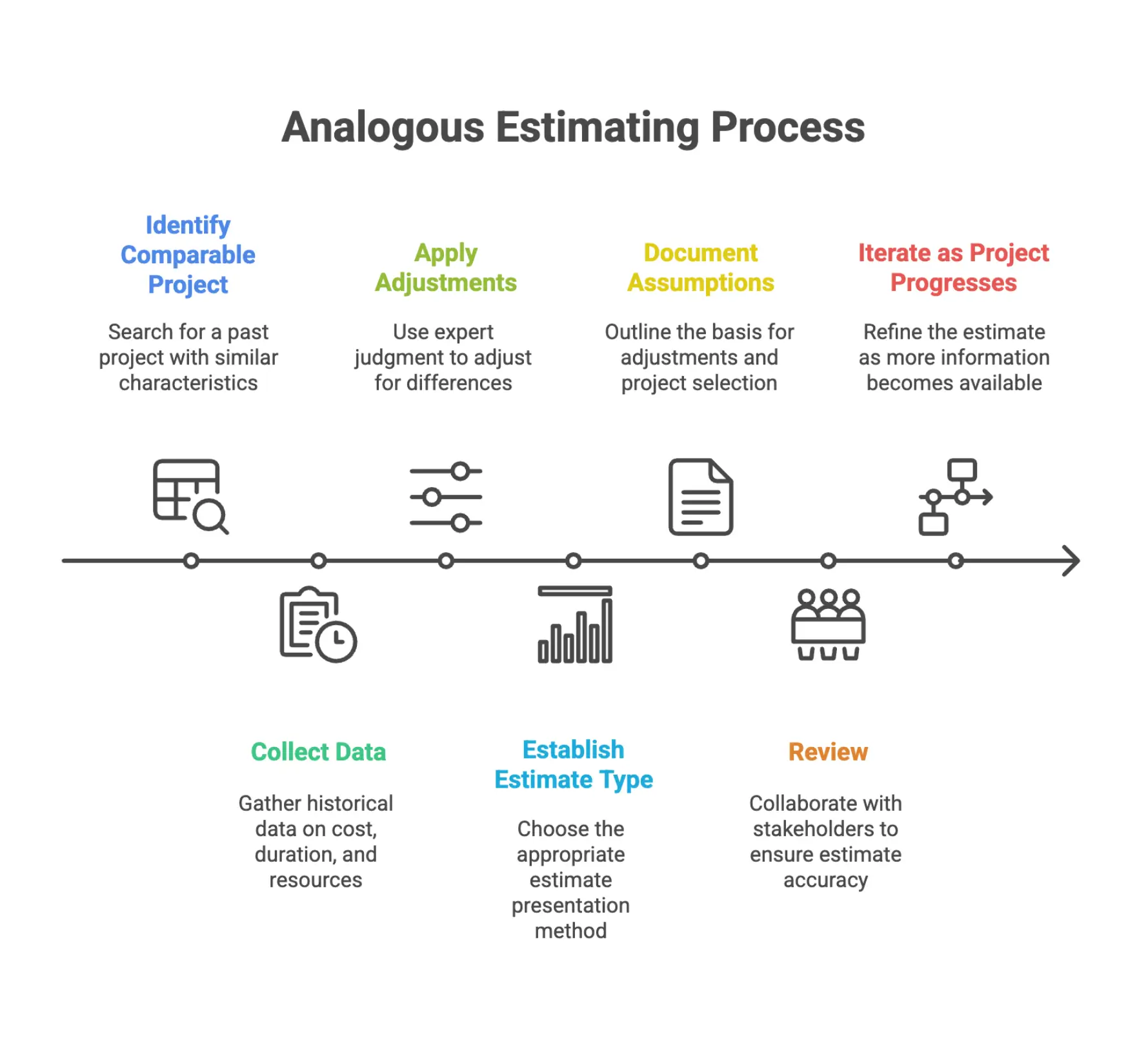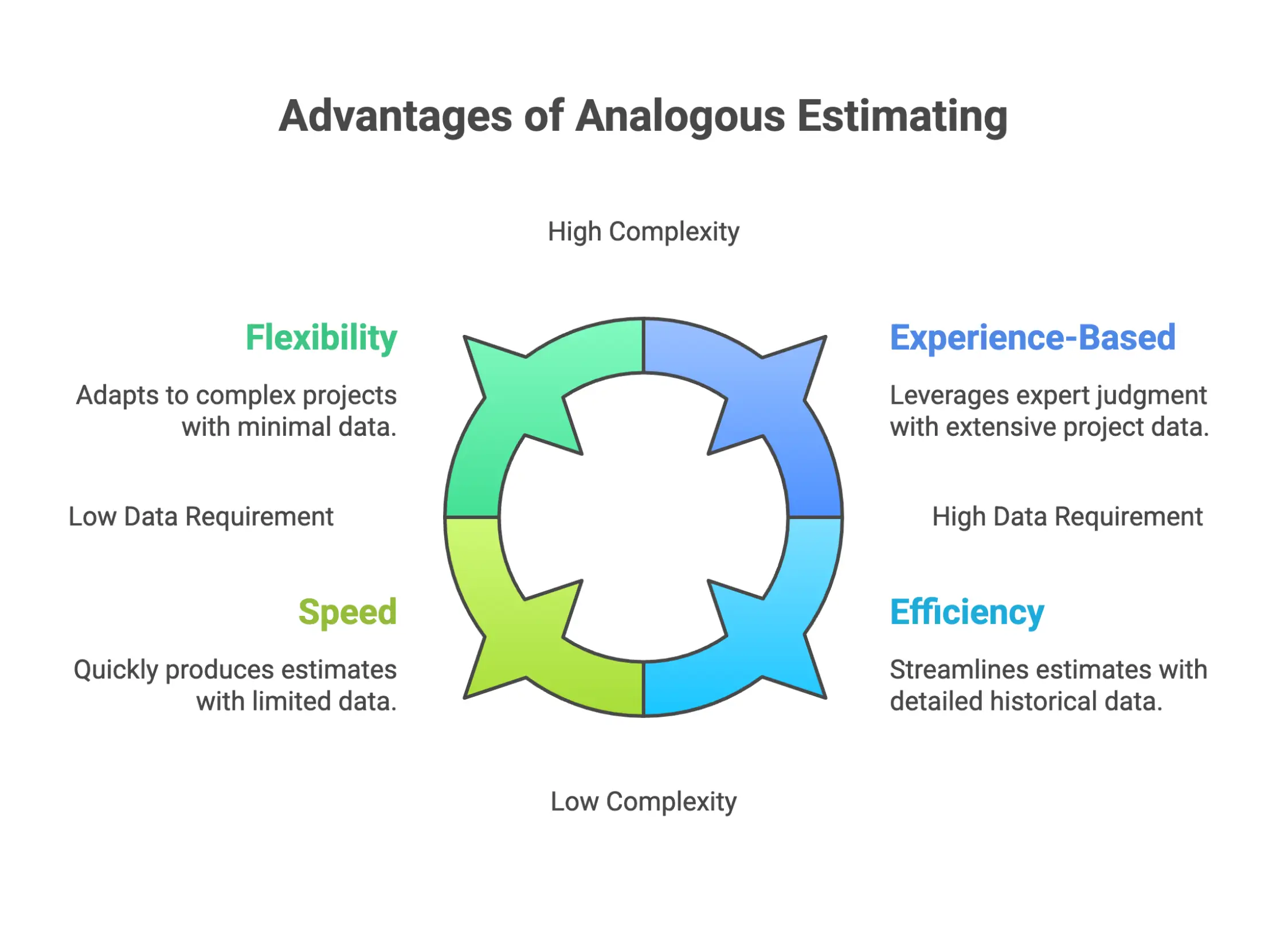

What Is Analogous Estimating? Project Management Guide
TL;DR: Analogous estimating is a project estimation technique that uses historical data from a similar past project to produce rough cost and duration estimates quickly, especially helpful in the initial stages with limited data. Project managers can apply analogous estimating to generate accurate estimates early, but the final estimate depends on how closely the chosen previous project matches the current project. This guide walks you through how analogous estimating works, when to use it, its differences compared to parametric estimating, and tips for applying the technique to ensure successful project outcomes.
What Is Analogous Estimating in Project Management?
Ever been tasked with producing a rough estimate for a new project before all the facts are in? You’re not alone. Project managers often need to make fast forecasting decisions during project initiation phase meetings, even with limited data. That’s where analogous estimating steps in, turning your historical data into actionable figures.
Defining Analogous Estimation: The Essentials
Analogous estimating, sometimes called top down estimating, is a project estimation method built for the initial stages of a project. Instead of requiring a detailed work breakdown structure (WBS) or granular scope, you look at past projects with similar parameters and use their outcomes as a starting point for your current estimate. The Project Management Institute (PMI) recognizes analogous estimating as an effective tool when detailed data is scarce.
In simple terms, you answer, “What is analogous estimating?” by saying: it’s a way to leverage the outcomes from a comparable project as a baseline for your own. If the previous project matches your new project in terms of scope, complexity, and context, you can generate a rough estimate for cost and duration. As Indeed puts it, analogous estimation is about making early duration estimates and cost predictions based on reliable historical project data.
For a deep dive on how analogous estimating works, don’t miss our analogous estimating guide filled with practical workflow tips.
When Should Project Managers Apply Analogous Estimating?
Project managers typically apply analogous estimating at the project initiation phase, especially when only limited data is available. It’s particularly valuable during early brainstorming, proposal development, and initial project planning, where there’s not enough information to use bottom up estimating or parametric estimation methods.
Scenarios Ideal for Analogous Estimating
- When project managers must provide a rough estimate to test project feasibility.
- During client proposal preparation, where a rough estimate based on similar past projects is required.
- To generate initial budget or duration estimates before detailed project scope or resources are defined.
- In software projects and construction where historical data from previous project outcomes are available.
This estimation technique works best when the current project is comparable to past projects, and reliable historical data exists. As projects progress and more information emerges, project managers typically refine these estimates with more accurate technique such as parametric estimating.
Types of Analogous Estimating Techniques
Analogous estimation isn’t one-size-fits-all. The technique can be tailored to fit the needs of the project based on available data, risk tolerance, and the level of uncertainty involved. Here are the main types recognized by the Project Management Institute:
1. Single Point Estimate (Absolute-Value)
You use one value from a similar past project and apply it directly to your current project. This approach works for fast estimation, but provides little insight into potential risks or variations.
2. Ratio Estimate
The ratio estimate describes a scenario where you adjust past project figures proportionally to fit your current project’s scale or parameters. For example, if your new building is 20% larger than the previous project, you scale the cost and duration estimates accordingly.
3. Estimate Range
Instead of providing a single point, you specify a low-high estimate range based on comparable project outcomes. Estimate ranges give stakeholders a sense of possible values reflecting uncertainty.
4. Three Point Estimating
Three point estimating considers optimistic, most likely, and pessimistic estimates for cost and time. This approach provides a quantitative assessment of risks and increases confidence in the final estimate. The statistical approach used in three point estimating can be further refined using statistical models to predict probable outcomes.

Key Differences: The main difference between analogous and other estimating techniques, such as parametric estimation, is the level of detail and reliance on project parameters. Analogous estimation uses broad similarities and expert judgment, while parametric estimation involves mathematical formulas and detailed data.
How to Apply Analogous Estimating: A Step-By-Step Approach
Here’s a practical process project managers can use to apply analogous estimating on a new project:
- Identify a Comparable Project: Search your database for a past project with similar scope, timeline, and complexity. The more closely the past project matches your current project, the more accurate your rough estimate will be.
- Collect Data: Gather historical data on cost, duration, resource use, and challenges from the previous project.
- Apply Adjustments: Use expert judgment to adjust for differences between the previous project and your current project. Consider factors such as labor rates, material costs, project scope, and market changes.
- Establish an Estimate Type: Choose whether to present a single point estimate, ratio estimate, estimate range, or use three point estimating based on project requirements.
- Document Assumptions: Outline the basis for all adjustments and the rationale for selecting the comparable project.
- Review: Collaborate with stakeholders to ensure the estimate reflects reality and aligns with organizational goals.
- Iterate as the Project Progresses: As more information becomes available, refine your rough estimate into a more detailed final estimate.

This estimating process allows project managers to communicate realistic expectations to stakeholders during project initiation, then progress to parametric estimating or bottom up estimating as project parameters become clearer.
Analogous vs. Parametric Estimating: Key Differences for Project Managers
Project managers often need to choose between analogous estimating and parametric estimating. Understanding the key differences ensures that you select the best estimation technique for your project.
Analogous Estimating
- Best for: Early stages, limited data, and when speed matters.
- Data Required: Past data from a similar past project.
- Accuracy: Depends on the quality of the historical data and the similarity between the projects.
- Role of Expert Judgment: Essential for making appropriate adjustments.
- Use Case: Early project planning, software development, high-level budgeting.
Parametric Estimating
- Best for: Later stages when more detailed data is available.
- Data Required: Quantitative historical data to establish cost per unit (hours, square footage, etc.) using statistical models.
- Accuracy: More accurate than analogous estimation if the data is comprehensive.
- Role of Statistical Models: Core to the estimation, reduces human bias.
- Use Case: Complex projects where precise cost estimate and duration estimates are required.

Analogous estimating works for the initial rough estimate. As the project progresses, parametric estimation using formulas and detailed data becomes the more accurate technique. Indeed UK and Tempo both underscore how blending these approaches throughout project planning maximizes accuracy.
Expert Judgment: Regardless of the technique, leveraging expert judgment and historical data improves estimate reliability.
How Analogous Estimating Works in Real-World Projects
Effective analogous estimating relies on sourcing timely, relevant historical data. Let’s see how project managers in different industries apply this analogous estimating technique.
Construction Projects: Making Rough Estimates Based on Past Projects
On construction projects, rough estimates for labor, materials, and duration are often drawn from previous projects with similar scope. For example, a flooring contractor facing a carpet replacement job will reference the cost breakdown from a comparable project, adjusting as needed for labor market changes or material cost differences. This approach enables them to communicate expected cost and duration estimates to clients during early stages. They do not have to wait for a finalized work breakdown structure.
Software Development: Leveraging Project Estimation Techniques
In software projects, project estimation techniques like analogous estimation help teams forecast cost and project duration early, using lessons learned from previous project releases. As the project scope becomes more defined, teams pivot to statistical models or parametric estimation for more accurate estimates.
Manufacturing and Engineering: Adapting to Changing Project Parameters
Manufacturing project managers use analogous estimating when starting a new project with limited data, calling on historical projects within the company. They apply ratio estimates to factor in changes in production volume, new regulations, or shifts in technology.
Integrating Cost Breakdown Structure (CBS) and Work Breakdown Structure (WBS) in Analogous Estimating
A well-structured Cost Breakdown Structure (CBS) is fundamental for project managers to produce accurate estimates and manage project costs effectively. Let’s clarify how CBS fits with analogous estimating and why it matters.
What Is a Cost Breakdown Structure (CBS)?
A Cost Breakdown Structure (CBS) is a hierarchical framework that categorizes and organizes all project cost items. The CBS provides a detailed breakdown of project expenses and aligns them with the project scope defined in the Work Breakdown Structure (WBS). A CBS is essential for project managers to estimate all project-related costs and prevent budget overruns.
- Tracking and Allocation: CBS allows project managers to accurately track expenses, allocate resources efficiently, and align costs with individual tasks and deliverables.
- Risk and Contingency: Including contingency costs provides a buffer for unexpected events and helps in proactive risk management.
- Stakeholder Transparency: By breaking expenses down, the CBS clarifies how funds are distributed, improving financial transparency and accountability.
Tip: Use CBS alongside WBS for integrated cost and schedule overviews. While WBS focuses on deliverables, the CBS maps out the cost of each element. Both are cornerstones of effective project management.
How to Build and Use a CBS
- Define Scope: Leverage the WBS to outline deliverables and work packages.
- Create Cost Categories: Identify and organize by labor costs, material costs, equipment costs, overhead, direct and indirect costs.
- Drill Down: Add detailed subcategories for granular tracking.
- Monitor and Update: Regularly review and update the CBS as the project progresses for ongoing financial control.

Regular cost breakdown analysis at project milestones uncovers deviations, inefficiencies, and risk areas. Comparing your estimates to actual costs highlights where the estimating process needs refinement.
Breaking Down Project Cost Categories for Better Estimates
Understanding the main categories of project cost within the CBS helps generate accurate estimates during analogous estimation. Here’s an overview:
- Labor Costs: Money spent on personnel categorized by roles and hours.
- Material Costs: Expenses for raw materials, supplies, and consumables.
- Equipment Costs: Costs of tools, machinery, or technology required.
- Overhead Costs: Ongoing organizational expenses supporting the entire project.
- Direct Costs: Tied directly to executing the project.
- Indirect Costs: Overhead that supports project delivery but is not task-specific.
By mapping these categories within the CBS, project managers ensure no major costs are missed, helping to generate more reliable rough estimates based on similar past projects.
The Role of Cost Breakdown Analysis
Cost breakdown analysis is the process of examining what drives the cost of every product, service, and project deliverable. It ensures accuracy in project estimation, identifies optimization opportunities, and supports competitive pricing strategies.
- Identify Cost Drivers: Uncover which categories contribute most to cost overruns and target improvements.
- Track Progress: Compare actual spending to initial projections for transparency.
- Include Contingency Margins: Account for unexpected costs to maintain profitability.
- Support Stakeholder Communication: Give teams and clients clear visibility into the allocation and use of project budgets
Regular cost breakdown analysis, especially at key milestones, ensures your financial assumptions remain realistic and that project managers can address risk early.
Advantages and Limitations of Analogous Estimating for Project Managers
Strengths: Why Project Managers Rely on Analogous Estimating
- Speed: Project managers can use historical data to produce rough estimate figures quickly, keeping momentum through the initial stages of planning.
- Efficiency: No need for full work breakdown structure or granular scope.
- Flexibility: Works with limited data, gets stakeholders engaged with early cost and duration targets.
- Experience-Based: Leverages expert judgment as well as previous project data.

Challenges: Accuracy, Data Quality, and Limited Data
- Similarity is Key: The quality of your comparable project controls the accuracy of your entire project estimate.
- Data Gaps: Incomplete or poor historical data reduces reliability.
- Changing Parameters: Scope changes, market shifts, and tech updates can make even a strong comparable project less relevant.
- Final Estimate Risk: Major deviations often require switching to more accurate technique or supplementing with additional statistical models as projects progress.
As a best practice, project managers should combine analogous estimating with other estimating techniques, like parametric estimation, as more detailed data becomes available.
Frequently Asked Questions on Analogous Estimating
What is analogous estimating and how is it used in project management?
Analogous estimating is a technique where project managers use historical data from a similar past project to make duration and cost estimates for a new project, especially valuable in initial stages with limited data.
What are the main types of analogous estimation?
Project managers use single point estimate, ratio estimate, estimate range, and three point estimating. Selecting the right method depends on data quality and project parameters.
How does analogous estimating differ from parametric estimating?
Analogous estimating relies on outcomes from previous projects and expert judgment, while parametric estimating uses mathematical formulas, statistical models, and detailed data for more precise results.
What role does expert judgment play in analogous estimating?
Expert judgment helps identify the most appropriate comparable project, adjust for differences, and account for project context, ensuring the rough estimate is grounded in reality.
Why are CBS and WBS important in cost estimating?
The WBS defines project deliverables and tasks. The CBS organizes all cost elements associated with those tasks. Used together, they improve the accuracy of estimates and provide clear budget visibility.
How can project managers generate accurate estimates for the entire project?
By combining historical data, expert judgment, cost breakdown analysis, and structured frameworks like CBS and WBS, project managers can produce accurate estimates even with limited data.
Ready to Take the Next Step with Modern Project Estimation Tools?
Curious about how project estimation software can improve your estimating process? Check out Nomitech’s full suite or get in touch to find a solution tailored to your team’s needs. Whether you’re making your first rough estimate or preparing detailed budgets, combining the right historical data, estimation technique, and modern tools ensures you’ll deliver accurate estimates and maintain financial control across your entire project lifecycle.




